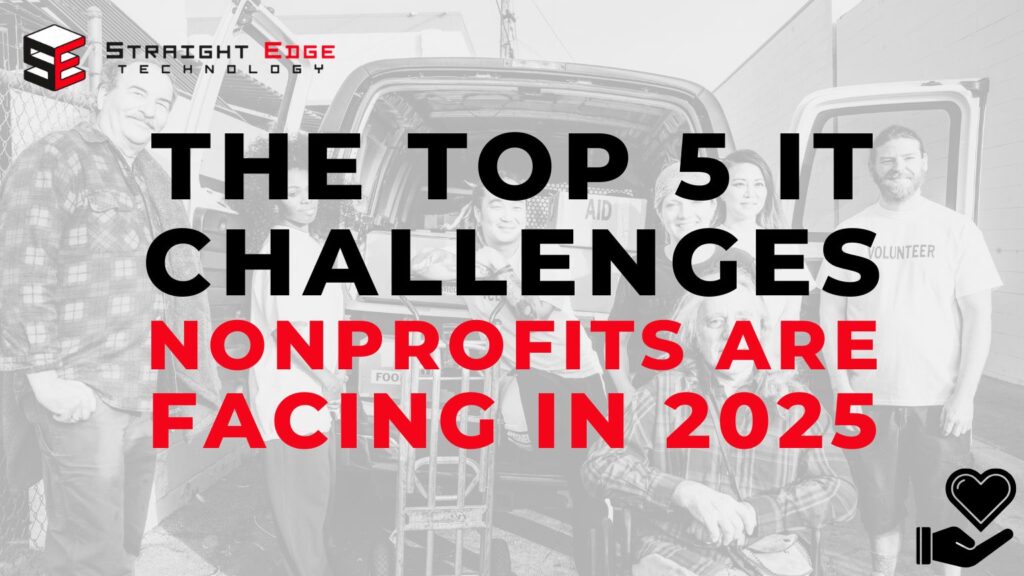In 2025, technology plays a more vital role in the nonprofit sector than ever before. Whether it’s managing donor data, enabling hybrid work, or ensuring program delivery, having the right IT infrastructure in place is essential. But with limited budgets, minimal in-house IT staff, and rising cybersecurity threats, many nonprofits struggle to keep up. As an MSP serving nonprofits in Texas, we see these issues every day. Here are the top 5 IT challenges nonprofits are facing in 2025—and how your organization can start solving them.
1 – Cybersecurity Threats Are Evolving Faster Than Budgets:
Nonprofits have become prime targets for cybercriminals. Why? Because many have limited security controls but still manage sensitive information like donor records, financial data, and client case files.
In 2025, we’re seeing a rise in:
- AI-powered phishing attacks
- Ransomware-as-a-Service (RaaS) targeting small and mid-sized organizations
- Breaches due to outdated firewalls and untrained staff
The consequences aren’t just technical, they’re reputational and financial. A single breach could compromise donor trust and impact future funding.
How to Tackle It:
- Enable multi-factor authentication (MFA) on all critical systems
- Provide regular, role-based cybersecurity awareness training
- Invest in endpoint protection that covers both in-office and remote devices
- Schedule a security risk assessment annually
2 – Managing Remote and Hybrid Workforces Securely:
Remote work evolved after the pandemic. Many nonprofit teams now operate in hybrid environments, with staff spread across homes, field offices, and partner locations. But supporting a distributed workforce brings But supporting a distributed workforce brings challenges:
- Inconsistent device security
- Weak or shared Wi-Fi networks
- Difficulty managing updates and access remotely
Without proper oversight, nonprofits risk data breaches, lost productivity, and frustrated teams.
How to Tackle It:
- Use cloud-based collaboration tools like Microsoft 365 or Google Workspace for secure access
- Deploy Mobile Device Management (MDM) to monitor and secure laptops and smartphones
- Set up VPNs or secure gateways for remote users
- Create a formal remote work policy with clear IT protocols
3 – Aging or Patchwork Technology Infrastructure:
Nonprofits often operate on aging systems cobbled together over the years through donations, grants, or outdated software licenses. This results in:
- Frequent downtime or slow performance
- Compatibility issues with modern tools
- Security vulnerabilities due to unsupported systems
In many cases, nonprofits are reactive, not proactive.
How to Tackle It:
- Schedule a full IT assessment to understand your current environment
- Build a 3-year technology roadmap that aligns with your mission and funding cycle
- Explore hardware refresh programs and nonprofit tech discounts
- Move to cloud-based platforms where possible to reduce infrastructure costs
4 – Compliance and Data Privacy Pressure:
From HIPAA to PCI-DSS and state-specific data protection laws, the compliance landscape in 2025 is complex and getting stricter. Grantmakers, donors, and partners increasingly expect nonprofits to meet these standards, yet few have the internal capacity to track compliance or enforce data privacy policies.
How to Tackle It:
- Identify which compliance standards apply to your organization (HIPAA, FERPA, PCI-DSS, etc.)
- Implement data encryption at rest and in transit
- Use role-based access controls to limit exposure of sensitive data
- Work with an MSP or virtual CIO to conduct regular compliance audits
5 – Limited IT Staff and Strategy:
Many nonprofits don’t have a full-time IT staff member—let alone a department. Technology responsibilities often fall to a “tech-savvy” staffer or volunteer, leading to:
- Burnout and inconsistent support
- Lack of strategic planning
- Reactive (not preventative) IT practices
Without an IT roadmap, even well-meaning nonprofits struggle to scale their impact with technology.
How to Tackle It:
- Partner with an MSP that specializes in nonprofits to fill the skills gap
- Ask about virtual CIO (vCIO) services to help with IT planning
- Create a basic IT policy manual for your staff and volunteers
- Build tech into your budget the same way you plan for staffing or outreach
You don’t need a massive budget to make smart IT decisions. With the right support and a strategic approach, your nonprofit can overcome these challenges and build a more secure, efficient, and impactful organization.

